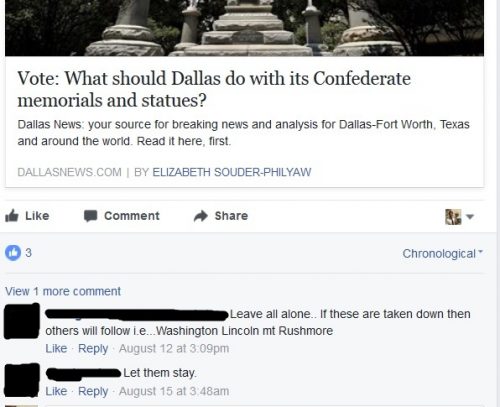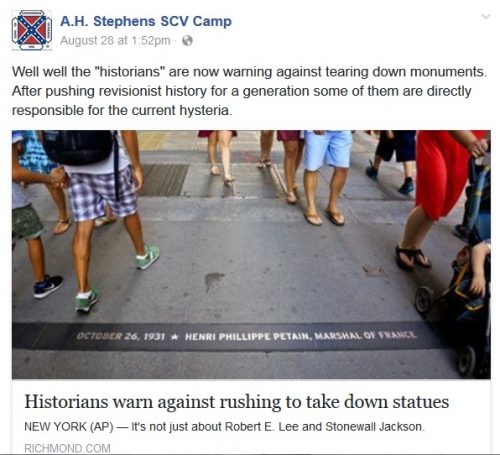The Resistance Files: Why Historians Often Talk Past Their Audiences – And How We Can Do Better
By Matthew Christopher Hulbert
For weeks now, marble and bronze likenesses of Robert E. Lee and his Confederate ilk have been – or are in the process of being – toppled from pedestals across the United States.
In response, a number of the nation’s foremost historians of the Civil War and Reconstruction have supported the removal movement, pointing out that many of these monuments don’t date to the war itself; they are white supremacist relics of the Jim Crow era (1890s to 1930s) and the heyday of massive resistance to desegregation in the 1950s.
Other historians have reminded us that Confederate political and military leaders committed treason against the United States in order to preserve the institution of slavery. For this reason, these historians argue, Americans should never have built monuments to them in the first place, and the sculptures should be removed.
Some scholars debate the value of monuments as art and as worthwhile reminders of past wrongs, while some have probed the extent to which battlefield parks and cemeteries should be considered museums and exempted from Confederate monument removal altogether.

These discussions have all prompted significant pushback from “Confederate heritage” adherents who deploy the “slippery slope” argument: that removal of Confederate monuments based on the ugly acts of their subjects will lead directly to the obliteration of the Founders from public spaces.
As a result of this tactic’s effectiveness (even POTUS bought into it), many well-meaning Americans are genuinely afraid that if we open the door to “erasing” the Civil War history we find shameful or distasteful, we’ll never be able to close it again. As historians including Annette Gordon-Reed and Jon Meachem have suggested in multiple essays and interviews, neither of these things will happen just because we remove Confederate memorials.
To echo the call recently made by Karen Cox: the time is undoubtedly right for historians to embrace our roles as public intellectuals. When we do, though, we need to understand why some history-loving Americans won’t like what we have to say. It seems that the more expertise that scholars provide in articles and op-eds, the less a significant part of the public trusts our intentions. For proof of this reaction, look no further than social media or the comment section of an op-ed.
Why is this? It may be because when talking about Confederate memorials, historians are talking about the past and history, but most Americans are talking about memory.
The Past
For historians, the “past” refers to people, events, ideas and objects that have gone before us. The past cannot be changed, it cannot be fully recovered, and it can never be truly repeated. We study the past through artifacts: manuscripts, letters, financial ledgers, material objects, oral histories, popular culture, and so on.
History
The act of exploring the past by using its artifacts is what historians do. We analyze how parts of the past changed over time, interpret why those changes occurred, and derive broader significance from them. And then we make arguments about it, producing “history” in the process.
Memory
“Memory” is how people – individually or collectively – remember and commemorate the past, through monuments, films, civic ceremonies, and festivals. Often, it involves “remembering” a past we didn’t even experience firsthand. But “memory” is not so straightforward; its narratives are designed, constructed, and disseminated to suit specific social, economic, or political agendas.
In some communities, different memory narratives compete for dominance. Over time, certain narratives ascend to prominence while others are forgotten. Dominant collective memories are usually misleading. They are intended to smooth over rough edges and to fill in gaps; they fabricate uniformity of past experiences to try to create a homogenous identity in the present.
The true power of memory, then, is that by controlling the way people remember the past, those in authority can exert immense influence over the way communities understand – and behave – in their own time.
The Disconnect
To most Americans, “the past,” “history,” and “memory” are more or less interchangeable. When they decry the removal of Confederate memorials as the erasure of history, people aren’t actually talking about history as historians know it. They’re referring to memory. And the “slippery slope” leads directly to their most familiar and cherished collective memories: Jefferson as the author of American freedoms; Washington as the icon of American valor and exceptionalism; and Lincoln as the martyr who died to save the Founder’s Union.
Historians underestimate the power of memory narratives in shaping most Americans’ beliefs about what happened in the past, and how closely their identities are bound to these beliefs. Memory is the mechanism through which most Americans employ the past to make sense of the world around them. When they worry about memorials to Washington and Jefferson and Lincoln coming down, they are actually worrying about losing their cultural – and nationalistic – bearings in the present.
What Should Historians Do?
The divide between historians’ concepts of history and the public’s memory has meant that we have often talked past our intended audience, especially in recent debates about Confederate memorials.
We cannot be satisfied with occupying the historical high ground. It’s not enough to argue that Confederate monuments are symbols of Jim Crow racism and then to assume that the public will immediately digest that knowledge and see removal as the only rational solution. And it’s not enough to think that if they don’t, they just don’t get it.
Even to the well-meaning public, this looks like sleight-of-hand. They’re thinking, “How did this just become a problem now if these statues are 80, 90, and 100 years old?” “Why are all of these academic historians suddenly swooping in to tell me how to feel about my history?”

In this context, historians’ arguments are recast as “political correctness” at best, or, at worst, as academic elites run amok (again), suborning the erasure of ugly history.
Historians must recognize that destroying or re-contextualizing Confederate memorials will result in the gradual obsolescence of specific memory narratives. After all, it was through building the commemorative landscape that Lost Cause adherents managed to dominate the conflict’s memory for decades, by smothering its opposition into obscurity.
Historians’ assurances that “knowledge” of the past will endure in the books and articles we author don’t put the public at ease. For them, artifacts aren’t the raw elements we use to create history, they are the last living bits of the past surviving in the present.
We have to make a stronger effort to understand how the general public “does history,” to understand why Americans would value a Confederate statue more than an argument made by a historian, as “history.” While historians access the past intellectually – analyzing artifacts and making arguments – most Americans access it physically and emotionally, by looking at monuments and visiting battlefield parks.
Historians must openly and honestly address these differences in their public writing about removing some monuments from public space (Lee and company) and defending others (the Founders and Lincoln). Doing so will hopefully convince Americans of our arguments, and of our intentions as historians.
This is a worthwhile strategic pivot because, to this point, historians’ interpretations of the past, however well-founded, have generally failed to win over the hearts and minds of our most sought-after audience: the people horrified by Charlottesville but still unsure of what its ramifications mean for them, the beliefs they have always had about American history, and their role in it.
Matthew Christopher Hulbert teaches American history at Texas A&M University – Kingsville. He is the author of “The Ghosts of Guerrilla Memory: How Civil War Bushwhackers Became Gunslingers in the American West” (Georgia, 2016), which recently won the 2017 Wiley-Silver Prize. He is also the co-editor of “The Civil War Guerrilla: Unfolding the Black Flag in History, Memory, and Myth” (Kentucky, 2015) and “Writing History with Lightning: Representations of Nineteenth Century America on Film” (LSU, under contract).
Featured image: Charlottesville, August 11, 2017, photograph by Zach D. Roberts, NurPhoto/Getty Images

